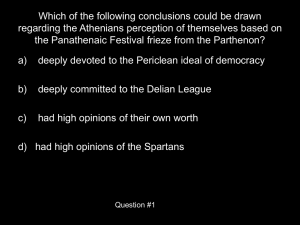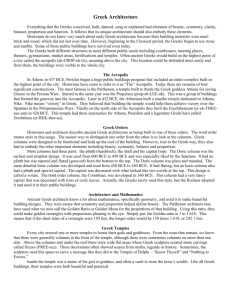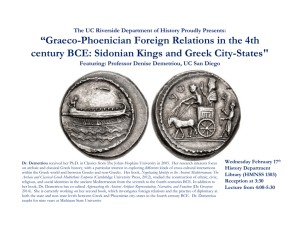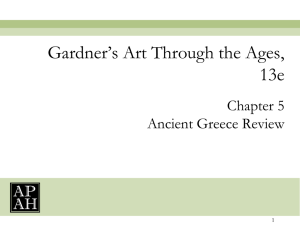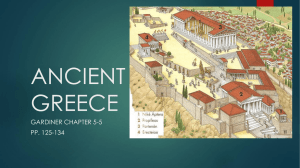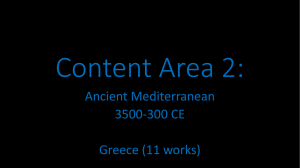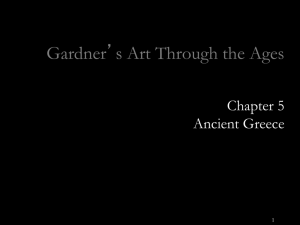Ancient Greek Art & Architecture: Key Artifacts & Sites
advertisement
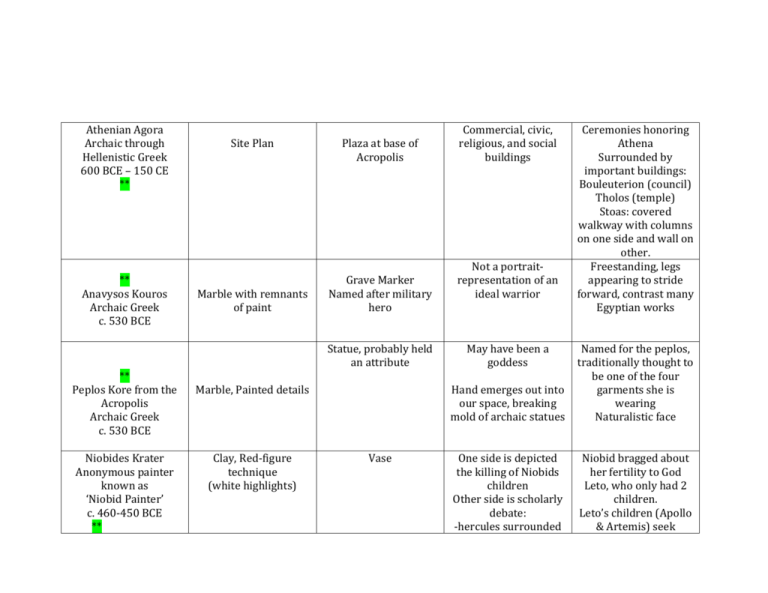
Athenian Agora Archaic through Hellenistic Greek 600 BCE – 150 CE ** ** Anavysos Kouros Archaic Greek c. 530 BCE ** Peplos Kore from the Acropolis Archaic Greek c. 530 BCE Niobides Krater Anonymous painter known as ‘Niobid Painter’ c. 460-450 BCE ** Site Plan Marble with remnants of paint Plaza at base of Acropolis Grave Marker Named after military hero Statue, probably held an attribute Marble, Painted details Clay, Red-figure technique (white highlights) Vase Commercial, civic, religious, and social buildings Not a portraitrepresentation of an ideal warrior May have been a goddess Ceremonies honoring Athena Surrounded by important buildings: Bouleuterion (council) Tholos (temple) Stoas: covered walkway with columns on one side and wall on other. Freestanding, legs appearing to stride forward, contrast many Egyptian works Hand emerges out into our space, breaking mold of archaic statues Named for the peplos, traditionally thought to be one of the four garments she is wearing Naturalistic face One side is depicted the killing of Niobids children Other side is scholarly debate: -hercules surrounded Niobid bragged about her fertility to God Leto, who only had 2 children. Leto’s children (Apollo & Artemis) seek ** Doryphoros (Spear Bearer) Polykleitos 450-440 BCE Roman copy of Greek original Acropolis Athens, Greece Iktinos & Kallikrates c. 447-410 BCE ** Acropolis Plan Parthenon Helios, horses & Dionysus Temple of Athena Nike Victory adjusting her sandal Plaque of the Ergastines Roman Copy (marble) by heroes -Warriors under protection of Hercules revenge, killing Niobid’s 12 Punished for hubris Statue Closed Stance Contrapposto Stance Alternating tense and relaxed elements of body Warrior and athlete Hand once held spear Averts gaze, you may admire him but he won’t recognize it. Temple to goddess Athena Symbol of birth of democracy Overlooking city & sea Large columns into bottom of temple. Greek Original (bronze) Marble Fortified hill within city (Acropolis) Doric temple Ionic elements in a Doric temple. Story of Athena and Poseidon vying for temple Grave Stele of Hegeso Attributed to Kallimachos c. 410 BCE ** Winged Victory (Nike) of Samothrace Hellenistic Greece c. 190 BCE ** Marble & Paint Grave Marker Woman examining a piece of jewelry from a jewelry box handed to her by standing servant Commemorates death of Hegeso, inscription ID’s her & father Marble Meant to stand in or above a fountain. Similar to figurehead of a boat Dramatic twist & Contrapposto of torso. Shows evidence of invisible wind, wet drapery Symbol of Victory (Naval victory in 190 BCE) Great Altar of Zeus & Athena at Pergamon Asia Minor (Turkey) Hellenistic Greek c. 175 BCE ** Great Altar Athena Plan Marble Architecture & sculpture Seated Boxer Hellenistic Greek c. 100 BCE ** Bronze Altar dedicated to Zeus Altar placed high on an elevated platform, dramatic flight of stairs 7 ½ foot high frieze over 400 feet long wraps around monument Ionic Columns Application of cire perdue – Lost wax Nude Fighter Helenistic Bronze Older man, past his prime, mostly defeated look. Blood dripping form face onto right arm and on head Smashed nose, cauliflower ears, hands wrapped in leather bands

